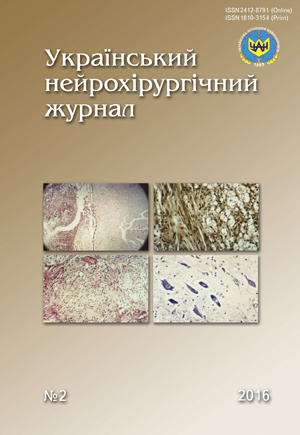The model of lateral spinal cord hemisection. Part I. The technical, pathomorphological, clinical and experimental peculiarities
DOI:
https://doi.org/10.25305/unj.72605Keywords:
model of spinal cord injury, left-side lateral spinal cord hemisection, experimentAbstract
Relevance of the topic. A promising tool for restoring the spinal cord function is the application of tissue neuroengineering. The approbation of its techniques is possible on qualitative spinal cord injury models that makes the transplantation of solid neuroengineered matrices feasible.
Objective. To optimize and test a model of lower thoracic rat’s spinal cord hemisection.
Materials and methods. 2 groups of experimental animals: 1 — mature animals (3–6 months, n=40) and 2 — young animals (1 month, n=32), the injury — left-side spinal cord hemisection (LHS) at Т11 level; monitoring of hindlimbs’ function (BBB scale), pathomorphological study.
Results. LHS provides simultaneous display of a slight, moderate and severe spinal cord injury (the correlates, respectively, are: the function deficit of a contralateral hindlimb [CH] and an ipsilateral hindlimb [IH] among the animals with better and worse recovery indicators). As of the 11th week of the observation a function indicator was 3,2±0,58 points under BBB scale and 5,31±0,79 (p<0.05) in group 2, which indicates a significant fullness of the intersection of all descending fibers. Mortality in group 1 at the stage of intervention and in the acute phase of trauma consists 25%, in the remote phase — 15%, including 5 percent of animals with bilateral injury. At full bilateral intersection mortality within 10 days with relevant conditions of detention comprises 100 percent.
Conclusion. LHS model is technically simple, easy to be reproduced, has low mortality under the condition of deep ipsilateral spinal cord function deficit, provides for three simultaneous options of spinal cord injury, is adapted for testing the neuroengineering tools.
References
1. Lee BB, Cripps RA, Fitzharris М, Wing РС. The global map for traumatic spinal cord injury epidemiology: update 2011, global incidence rate. Spinal Cord. 2014;52(2):110–6. [CrossRef] [PubMed]
2. Onifer SM, Rabchevsky AG, Scheff SW. Rat models of traumatic spinal cord injury to assess motor recovery. ILAR J. 2007;48(4):385-95. [PubMed]
3. Lemmon VP, Ferguson AR, Popovich PG, Xu XM, Snow DM, Igarashi M, Beattie CE, Bixby JL; MIASCI Consortium. Minimum information about a spinal cord injury experiment: a proposed reporting standard for spinal cord injury experiments. J Neurotrauma. 2014;31(15):1354–61. [CrossRef] [PubMed]
4. Tsymbaliuk VI, Medvediev VV, Senchyk YuYu, Molotkovetz VYu, inventors; Romodanov Neurosurgery Institute, Kiev, Ukraine, assignee. Method for modelling spinal cord hemisection in low thoracic level in rats. Ukraine Patent 92522. 2014 August 26.
5. Li Y, Oskouian RJ, Day YJ, Kern JA, Linden J. Optimization of locomotor rating system to evaluate compression-induced spinal cord injury: correlation of locomotor and morphological injury indices. J Neurosurg Spine. 2006; 4(2):165-73. [PubMed]
6. Sedy J, Urdzikova L, Jendelova P, Sykova E. Methods for behavioral testing of spinal cord injured rats. Neurosc Biobehav Rev. 2008;32(3):550-80. [CrossRef] [PubMed]
7. Burke DA, Magnuson DSK. Basso, Beattie, And Bresnahan scale locomotor assessment following spinal cord injury and its utility as a criterion for other assessments. In: Chen J, Xu X-M, Xu ZC, Zhang JH, editors. Springer Protocols Handbooks: Vol.2. Animal models of acute neurological injuries II: Injury and mechanistic assessments. New York–Dordrecht–Heidelberg–London: Springer, Humana Press; 2012. p. 591–604. [CrossRef]
8. Nozdrachev AD., Poliakov YeL. Anatomia krysy [Anatomy of the rat]. St. Petersburg: Lan’; 2001. Russian.
9. Majczynski H, Slawinska U. Locomotor recovery after thoracic spinal cord lesions in cats, rats and humans. Acta Neurobiol Exp (Wars). 2007; 67(3):235-57. [PubMed]
10. Tsymbaliuk VI, Medvediev VV. Spinnoj mozg. Elegia nadezhdy [Spinal cord. Elegy of hope]. Vinnitsa: Nova Knyga; 2010. Russian.
11. Filli L, Zorner B, Weinmann O, Schwab ME. Motor deficits and recovery in rats with unilateral spinal cord hemisection mimic the brown-sequard syndrome. Brain. 2011;134(Pt8):2261–73. [CrossRef] [PubMed]
12. Webb AA, Muir GD. Compensatory locomotor adjustments of rats with cervical or thoracic spinal cord hemisections. J Neurotrauma. 2002;19(2):239–56. [CrossRef] [PubMed]
13. Ung RV, Lapointe NP, Tremblay C, Larouche A, Guertin PA. Spontaneous recovery of hindlimb movement in completely spinal cord transected mice: a comparison of assessment methods and conditions. Spinal Cord. 2007;45(5):367–79. [CrossRef]
Downloads
Published
How to Cite
Issue
Section
License
Copyright (c) 2016 Vitaliy Tsymbaliuk, Volodymyr Medvediev, Vera Semenova, Nina Grydina, Yuriy Senchyk, Olga Velychko, Sergiy Dychko, Victoria Vaslovych

This work is licensed under a Creative Commons Attribution 4.0 International License.
Ukrainian Neurosurgical Journal abides by the CREATIVE COMMONS copyright rights and permissions for open access journals.
Authors, who are published in this Journal, agree to the following conditions:
1. The authors reserve the right to authorship of the work and pass the first publication right of this work to the Journal under the terms of Creative Commons Attribution License, which allows others to freely distribute the published research with the obligatory reference to the authors of the original work and the first publication of the work in this Journal.
2. The authors have the right to conclude separate supplement agreements that relate to non-exclusive work distribution in the form of which it has been published by the Journal (for example, to upload the work to the online storage of the Journal or publish it as part of a monograph), provided that the reference to the first publication of the work in this Journal is included.









